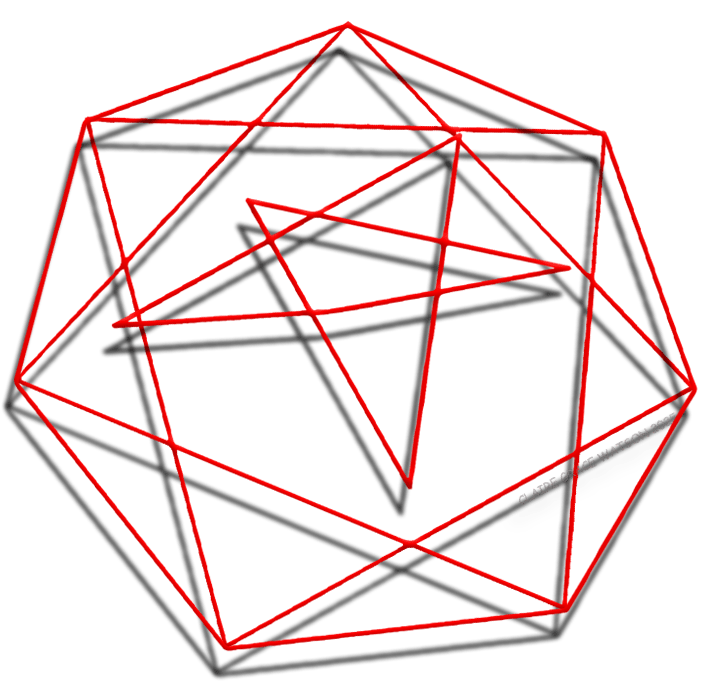
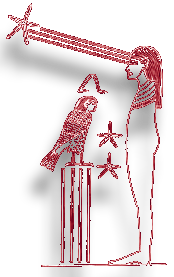
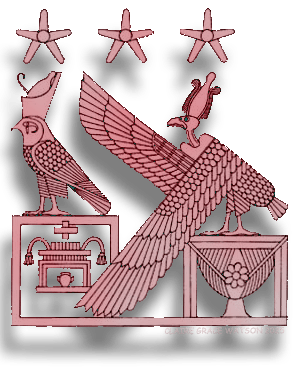
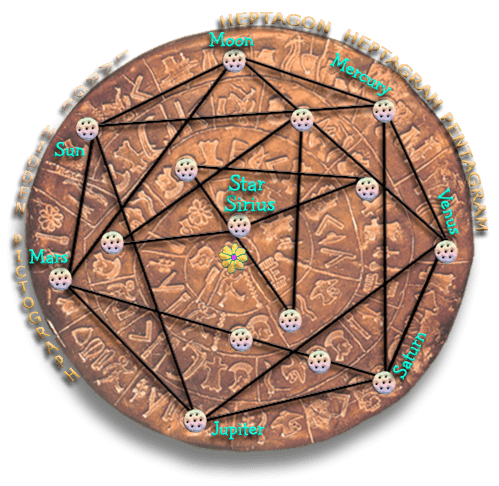
Plutarch and Plotinus between them give accounts of the ancient world-view involving numerology and the sexagesimal system of counting that is clearly preserved on the Phaistos Disk. These accounts relied heavily on mathematics and involved the emergence of the physical world from the womb of the goddess Rhea, as in Emanationism with the difference being the sex of God/dess.
Formed in Rhea's womb were 5 main
divisions of layers or cosmic stuff (cosmoi), and into these layers or firmaments formed 60 soul spaces made of 60 types of
soul-stuff, comprising 240 individual souls made of 48 different archetypes (or constellations). The 5 layers are the spirals on both
sides of the disk (below, right column), the pictographs removed to see the spirals better. Each outside spiral has 12
line segments; 8 inside spirals have a combined 36 line segments. The spirals are divided into 60 line segments
(30 Side 1, 30 Side 2). The 60 soul spaces in Rhea's womb are the total number of line segments on the disk, the 240
individual souls she creates is the total number of pictograph impressions, and the 48 soul types is the number of unique signs on the disk.
These numbers in bold also reveal the mathematics of the times that may have involved
the sexagesimal system of counting, perhaps with calendar applications.
And in these sixty spaces dwell the souls, each one according to its nature, for though they are of one and the
same substance, they are not of the same dignity. (Plutarch) The 48 archtypes, or "ark types," probably were the earliest named constellations, which we have inherited from Crete and which remain 48. Since the Minoans' astronomical system included viewing them as "ark types," then we should credit the Minoans with the birth of "modern" astrology, although it was born a very long time ago and became something else before it became itself again. In modern astrology we know our star sign as the constellation under which were born, determined by the month in which we were born. According to modern astrology, our star sign does in fact indicate our "soul stuff" of which we are made and which is supposed to determine our behavior and thought processes.
Connect these identical Heaven-Walker pictographs with lines to draw the Taurus constellation. The Heaven-Walker was renown...
...in those days [of ancient Egypt] of initiate kings and rulers and sages who occupied themselves with the Sacred Science,
when the clear Aether spake face to face with them without disguise, or holding back aught, in answer to their deep scrutiny of holy things...In those
days so great was their love of the holy mysteries, so high their virtue, that they left the earth below them, and in their deathless souls
became 'heaven-walkers' and knowers of things divine. (Thrice-Greatest Hermes, G.R.S. Mead)
Constellation Taurus as it is seen on the Phaistos Disk (above left) and the constellation as it is drawn today (above right).
The spirals on the disk are divided into 60 line segments. This would indicate a relationship of the disk to early astronomy, and it would also indicate the Minoans' reverence for astronomy, the science that maps the skies. In the Minoan world-view, as preserved on the Phaistos Disk, the sky is the womb from which humanity is born, each soul based upon a constellation that determines its soul type. The 60 line segments therefore are "sacred," and are emanated by the great goddess Rhea and can be seen flowing out of her in a spiral from the center of the disk.
Later on, in Early Common Era Gnosticism, a more modern mythology grows from this ancient knowledge that involves planetary rulers and the passwords required to negotiate them.
The sacred 60 is significant because long before 1,700 BCE the 60-system of counting was used by the Mesopotamians, who were avid astronomers as were the Egyptians. The application of the sexagesimal (60-system) system in astronomy was continued by Greek and Hindu
astronomers until about 500 CE. Since most of the constellation names originated in Crete and Greece, it is safe to say that because of the
symbols on the disk and the knowledge of the use of the 60-system by Greek astronomers much later, the 60-system was employed by the Minoans
in their astronomical calculations. The three 60's--the 60 soul spaces defined by the Phaistos Disk, the 60 of the 3-4-5 triangle (3x4=12x5=60, right triangle), and
the 60-system of counting in astronomy--are inseparable syncretisms, in terms of symbolisms found on the disk.
And they (crocodiles of the Nile) lay sixty [eggs] and hatch them out in as many days, and the longest-lived of them
live as many years-which is the first of the measures for those who treat systematically of celestial [phenomena].
(Timaeus of Plato, in Thrice-Greatest Hermes, G.R.S. Mead, Vol.3, p.198)
That is (re: the celestial phenomena), presumably, either the 60 of the Chaldaeans, or the 3x4x5 of the 'most perfect'
triangle of the Mathematici. (Israel Regardie, The Golden Dawn)
The most perfect triangle, the right triangle, "has its perpendicular [side] of 'three', its base of 'four,' and its
hypotenuse of 'five...' (The Cosmopolite in Les Mystere des Cathedrales, Fulcanelli;)
And one might conjecture the Egyptians [also revered] the fairest of triangles, likening the nature of the universe
especially to this... (Regardie)
The Egyptians, millennia before Pythagoras, employed the magic 3-4-5 triangle of the Pythagorean Theorem, c2=a2+b2.
The result, 25, was the number of letters in the Egyptian alphabet. (W. Marsham Adams in Mead)
And five makes a square equal to the number of letters among Egyptians, and a period of as many years as the Apis lives.
(Mead)
Again, by the relative position of its (the ibis') legs to one another, and [of those] to its beak, it forms an equilateral triangle...
(Wallace Budge in Mead )
Not only the number 60 but also the number five was sacred because it symbolized the hypotenuse of the "perfect" 3-4-5 triangle,
the right triangle of the Pythagorean Theorem, divinized on the Phaistos Disk 1200 years or so before Pythagoras proved it.
For the 'three' is the first 'odd' and perfect; while the 'four' is square from side 'even' two; and the 'five'
resembles partly its father and partly its mother, being composed of 'three' and 'two.' (Plutarch in Mead, Vol.1, p.234)
We must, accordingly, compare its (right triangle) perpendicular to male, its base to female, and its hypotenuse to the offspring of
both; and [conjecture] Osiris as its source, Isis as receptacle, and Horus as result. (Plutarch in Mead, Vol.1, p.234)
Interesting the geometry that emerges when the five five-branched pictographs on side one are connected with lines. The image seems like a graphical dissertation on triangles.
I also think that "Phi-stos" Crete was the center for the study of these sciences and may also have been the center for pottery. This vase pictograph, for example, is so similar to this vase excavated at Phaistos. Noticably on the vase is a spiral and a
design resembling the symbol for f, the Greek letter Phi.
The magnificent palace at Phaistos was overshadowed by Knossos alone. Phaistos was:
...a palace only less extensive than that of the Cnossus kings. Phaestus becomes a Cretan Piraeus, in love with commerce
rather than with art. And yet the palace of its prince is a majestic edifice, reached by a flight of steps forty-five feet wide; its halls
and courts compare with those at Cnossus; its central court is a paved quadrangle of ten thousand square feet; its megaron, or reception room,
is three thousand square feet in area, larger even than the great Hall of the Double Ax in the northern capital. (Durant)
At Phaestus, about 2000, he builds ten tiers of stone seats, running some eighty feet along a wall overlooking a flagged court. In Middle Minoan I the earliest palaces occur: the princes of Cnossus, Phaestus, and Mallia build for themselves luxurious
dwellings with countless rooms, spacious storehouses, specialized workshops, altars and temples, and great drainage conduits that startle the
arrogant Occidental eye.
This Phaistos Disk pictograph may be the primitive symbol for Pi, 3.1416,
to describe the properties of a circle. The short line of the symbol is the radius (r) of a circle and the long line is the diameter (d).
The ratio of the circumference of a circle (c) to its diameter (d=2r) is a constant number called Pi, which equals c divided by 2r+3.1416.
Today the chorus is singing, "This is the dawning of the Age of Aquarius," but when the disk was created it was the dawning of the Age of Aries from which came the Greek legend of Jason and the Argonauts. It was preceded by the Age of Taurus, supposed to have
been between 4320-2160 BCE (4525-1875, dates vary). An Age, lasting about 2,000 years or so, receives its name from the sign through which the
sun passes year after year as it crosses the equator at the Spring equinox (equal night), when night and day are equal in length all over the world,
each lasting 12 hours on this day.
During the Mediterranean Bronze Age, the Aegean people were making a transition from the Age of Taurus and old religion of
bull-worship to the Age of Aries. This was no less a transition from a primitive, idolatrous religion, tied to millenia of Dualism as basic to religious thought, to the beginnings of a scientific-philosophic
world-view and Emantionism and the "One" source of life. The Minoan ascendency over the bull is dramatized perhaps by the bull sports at the center of their festivities.
When the shift comes and the ages change from Taurus to Aries, the worship of the bull is not transferred to the worship of the ram, but instead the worship becomes
a quest for god/dess, who is conceived of in such a way as to be sought after. With the Minoans comes the idea of the Seeker and, for them, as well as for the evolution of consciousness, the Seeker of knowledge is finally the same thing as the Seeker of God/dess.
Perhaps this seeking after the goddess in the sky motivated the development of astronomy in Minoan Crete, with the idea that if we
invent telescopes and binoculars and astronomical measuring devices, we can seek the goddess through seeing her, getting closer to her and
knowing her well. Perhaps this astronomical questing for the divine led to our recognition of the universal powers of time and infinity and
the higher powers of destiny, and to conclusions about such things we might have drawn from stargazing. For the Aegean people, these eternal powers
seemed to emanate from the stars, and it stands to reason that the biggest star, Sirius, must be the most powerful. Therefore, from this star,
an eternal and perfect goddess high in the sky, flow all the gifts in heaven and earth.
Even today, we recognize the energy-power of the stars and their ability to influence our lives, so we should not be surprised that Bronze Age people regularly worshiped the stars as gods and as the glittering eyes of gods. Was their worship a deeper one than ours? In our modern knowledge and thinking, we know the stars are not gods, but are they not as gods to us? The Bronze Age star worshipers believed the stars were their forebears and neighbors. Do we not believe the same thing? In the stars, they believed, lies immortality. To the ancient Egyptians, immortality meant engaging the Ba, the earth-self, in a merger with the immortal overself and spirit-soul, the Ka. For them, the key to immortality was clear whereas for us, we seem to be always in some kind of state of confusion about it. Perhaps that is the fault of our religions that seek to impress their dogma upon us rather than inspire us to just assume our divinity and then explore it. Our relationship with our spirit-soul is something many of us give over to religious institutions when we never had to and we most definately shouldn't. How much better it would be, now that we know we are composed of subatomic particles, to understand our relationship to them rather than to worship some supposed divinity outside of ourselves. (Lampoon Dictionary of Partycall Fizz666)
The ba was a psychic force...Then it became the possessor of imperishable powers... (The Gods and Symbols of Ancient Egypt, Manfred Lurker, Thames and Hudson, publishers, 1974, p31).
The ka was born with a person. Many representations show the god Khnum fashioning the child and its ka on a potters wheel. The ka accompanied a person like a kind of double, but when the person died the ka lived on. 'To go to one's ka' meant 'to die', since the ka then left its mortal house and returned to its divine origin. (Lurker, p73).
Tomb paintings and papyri of the New Kingdom show the ba in bird-form hovering above the mummy of the deceased. (Lurker, p31).
Above left, the ba of mummifed Ani hovers above while Nephthys and Isis in the form of hawks stand at either end.
In personal meaning, this moment, this now, is our Mer, our place of ascending. The Merkaba vehicle is comprised of beingness established by the earth-self, who intentionally united itself with the soul-self, the Ka. The beingness of the earth-self unites itself to the beingness of the soul self for purposes of achieving immortality. The merger begins as one begins to assimilate the starlight
The purpose of symbols is not to reveal the hidden relationships between earthly phenomena in a rationalistic way but rather to point to the irrational. Knowledge of cosmic order was one of the secrets which were withheld from the profane. The title 'Master of Secrets', common in the Old Kingdom, is to be understood in this way. A symbol is meant to direct the initiate to something higher and to reveal it to him at the same time, but it must also conceal this from the ignorant. Knowledge of the meaning of images was not accessible to everyone...A symbol has manifold significance and therefore its origin and purpose cannot often be explained satisfactorily. Sometimes the symbol seems to contradict itself. There are, in fact, symbols which refer to both poles of existence: life and death, good and evil. (Introduction, The Gods and Symbols of Ancient Egypt, Manfred Lurker, Thames and Hudson, publishers, 1974.)
And into this ancient world with these beliefs, a new divine Curete and Olympian is being born to a mother in Crete. The priests are called, the warriors assemble with their shields, and the dancers prepare. But what of the child's destiny? Which argotype is the child, what soul-stuff is it made of, what soul space is it born into, under what planet and what Olympian, under what star sign, and in which hour of which day of which month? All of these can be determined by the priests of Rhea and oracles of Dodona, who can predict precisely the fortune of the baby, and with the Phaistos Disk in hand so can we. The child cannot go astray when a birth horai-scope is cast, when a guide is present, and when the path is lit by the bright eyes of the stars who are the omniscient Olympians, the goddess shining down from the sky and seeing everything.
Born on the third day, under the protection of Hades, the son may become an architect like Daedalus, builder of palaces. (1) The daughter may become an oracle at Dodona, wise in the ways of prophecy and careful to give good instruction to seekers. (2) Or she may be high priestess of the Sacred Oak. (3) The son has a second vocation, no less important than that of Aeson, seeker of the golden fleece. (4) And he will have good fortune and find the fleece and return it to Zeus, as prophesied. (5) Whenever the child is born, the warriors take their places (6) and the dancers assemble (7) so the celebration can begin. The warriors begin banging their shields to drown the cries of the baby so Kronos cannot hear them and take it. This protects the baby from dying right away, as child death in childbirth might certainly have been a problem in the Bronze Age. Born on the 5th day, under the protection of Hera, the child is destined for greatness, yet not so much as being born in the first two layers of the spiral. Moving into the 3rd layer or firmament, into which Rhea pours her children, this layer of soul-stuff is further from the goddess and is losing its divine potential. Now, the daughter is the priestess of the Sacred Oak (1) at Dodona, but not the high priestess, and the son no longer builds palaces but paved roads (2) instead. He may become a carpenter or leatherworker and make use of an awl which, syncronistically, could also be a telescope and a higher calling to astronomy. (3)
On the birthing stone (Phaistos Disk) this design of the starry goddess must surely have been concealed from all but the priests. Its presence explains the Emanationist idea or religious philosophy behind the method of augury in the birth of a child and the divination of its probable future. The augury continues in the 4th and 5th layers, where some vocations and professions are not so lofty but still important to the operation of the brilliant civilization of Minoan Crete. Perhaps the warriors, the dancers and the priests could be hired to perform the services associated with Birthing the Immortals in Bronze Age Crete. Notable repetition of signs appear on the Disk.
There is an ancient power I call the Watcher Unseen and that I believe encouraged these Minoans and Egyptians in these studies, and perhaps this is actually God responding to those who study God. If we study how God made the universe then perhaps God takes a special interest in the one who studies, and that begins a bond to enable creativity. I have often wondered about the name of the civilization I study -- Crete -- and how similar it is to Create. And then there is Daedalus, the great creator whose name symbolizes innovative creativity. To me, these things are all related.
I know about the Watcher Unseen because I manifested one who is in my life and who encourages me to take a profound interest in this. Left is a version of the Watcher as a Winged Disk from the Egyptian Book of the Dead. The Watcher Unseen comes down by penetrating the barrier separating the abstract world from the concrete world. The Watcher showers its earthly counterpart with tiny stars, sealing it against corruption and death and perhaps in response to a prayer. This whole part of my research, and my personal mystical experiences as a result of it, encourage me to think of God as existing entirely in potentia. And it makes God a very considerate being who practices non-interference unless called upon by prayer or by study of "divine things", which is like a prayer. So people who say God is dead are absolutely correct as relates to them. And that's a nice God also that lets people be absolutely correct like that. What a decent, respectful Geometry God/dess is!
Is it possible these studies of mine on this subject are like a prayer? I think so. Prayer does not always have to be about asking God for a favor. Prayer can be something like a Psalm or a chant or even an intense thinking about how God created the universe with geometry. And then you have to wonder, of course, about the nature of "God" and how it is transcendent of our idea of it. So, whatever you think God is, that's not God. But you do have a path to start walking in that direction and that path is you. You can start by wondering what and who you are and how it is you are conscious in the world/whorl.
Whatever the case, my studies on these subjects summoned the Watcher Unseen who watches me, communicates telepathically with me, makes meaningful and comforting sounds all around me, showers me with soothing vibrations of healing energy which certainly could be disks and stars, but who remains unseen and essentially unknowable. My thinking about these things has evolved and I come to think of this divine being as my Ka or higher self/genius, which everyone has. Yes, everyone has a Ka but not everyone has reconnected with their Ka. I like the way Joseph Campbell puts it. "The God is within YOU." That satisfies my understanding of Ka and it also creates in me a protector of subatomic particles and a writer in the genre of particle metaphysics, which gives a clue, I guess you could say, of my deeper understanding of so-called "God."
The manifested Watcher Unseen is rare now, not like in the old days of ancient Egypt and Minoan Crete where I believe it was fairly common, probably because of how people perceived their relationship to God and the universe and even the efforts they made to comprehend it. We may have actually lost a close relationship to God that we used to have thousands of years ago. I can see how that could happen. I don't think we can assume that God is always present regardless how badly we behave or how erroneously we think. If God is not an active, communicating presence in one's life, there is a remedy but it requires a major change of focus. Not many people are willing to do that.
In ancient Egyptian images, the deity is a winged being, something we identify as an angel. The Minoans conceived of Goddess Rhea as being the star Sirius, the star called Sopdu by the Egyptians (and Sothis by the Greeks) who conceived of it as being the goddess Isis. The Egyptians set their Sothic calendar according to the movement of this great goddess in the sky. The Phaistos Disk may also be a Minoan Sothic calendar that reckons time according to the movement of this star, as perhaps observed at the Great Pyramid by the Minoans.
Much later on in history, the Greek name for god was Zeus. The Minoans had another name for God, but what was it? According to Will Durant in Life of Greece, the Minoan name for Zeus was Velchanos (Vel-ka-nos). Whatever name they gave god, it surely acknowledged the feminine and might have meant movement and infinity.
There is a myth centered on the Minoan world, written by Plutarch more than a thousand years later, about the Minotaur, a bull-being son of Zeus and King Minos and child of Pasiphae, who was destroyed by Theseus with the help of his half-sister, Ariadne. Likewise
Dionysis, son of Zeus and the king of Crete and the child of Persephone, was destroyed by Titans with the help of his sister. His mother
had been seduced by Zeus, who appeared to her in the form of a serpent. After his birth and the strange death of his mother (she was burned to a
crisp upon glimpsing Zeus), Dionysis as a fetus was rescued by Zeus from the ashes. Zeus slashed a hole in his thigh and stowed the fetus away
in the wound. I think this is what is portrayed on a facted stone of green Jasper from Siteia, Crete, where we see the fetus inside the thigh. (below)
In nine months a baby was born from the thigh of his father.
We think of the constellation Taurus as a bull, but classical Greeks apparently thought of it as Zeus disguised as a bull.
Perhaps the Minoans thought of the constellation as Dionysis concealed in the thigh of Zeus, who was disguised as a serpent. Suppose this is the
fetus of Dionysis (said to have been called Rhadamanthus by the Minoans) in the thigh of his father Zeus or Velchanos. This picture writing sign
therefore shows something about the merger of these two gods, written in early script as the merger of the comb with the cucumber. In nine months
a baby was born from the thigh of his father, and perhaps the comb and cucumber indicate nine months time, as well. Perhaps this series of pictographs
shows how long one expects to be with child, although it seems pretty remarkable that it has to do with two men, one of them pregnant with the other.
Whether the Watcher Unseen is Ja-wa or Rhe-ah or Who-ah ever it is, I am glad to have the benefits of the company of such a distinguished Presence at the center of my life and encamped in my house.
Perhaps the Phaistos Disk artist had this design above in mind but lacked the materials to create it. My apologies to the original artist(s), but I just went ahead and colorized the Phaistos Disk pictographs and star and planets design, with the shield/disk locations indicated by circles of white light. Among all the other things it likely represents -- Sirius and the seven planets, the path of Venus, the North Star--I think it also represents the moment consciousness evolves and expands, the moment of enlightenment--the starlight infused moment of self-realization when you become the eternal YOU.
Copyright Notice - Disk of the World - Text and images copyrighted March 21, 1993-2025, Claire Grace Watson, B.A., M.S.T., U.S. Copyright and under the Digital Millennium Copyright Act of 1998, All rights reserved. No part of this web page may be reproduced or transmitted in any form or by any means without written permission from the author, except for the inclusion of brief quotations in a review.

![]() As example, I am born under the constellation Taurus, a constellation that I believe is "abbreviated," along with the other 47 constellations, on the Phaistos Disk. Taurus is the Bull's Foot pictograph. (left) The Bull's Foot appears twice on the disk, both times on side one and each time with a Heaven-Walker. (left) The Bull's Foot appears upside-down in relation to the Heaven-Walker, so perhaps the indication is the Bull's Foot is above or in the sky. Perhaps this two-pictograph combination also implies Serapis, the sacred Osiris-Apis bull worshipped in Egypt.
As example, I am born under the constellation Taurus, a constellation that I believe is "abbreviated," along with the other 47 constellations, on the Phaistos Disk. Taurus is the Bull's Foot pictograph. (left) The Bull's Foot appears twice on the disk, both times on side one and each time with a Heaven-Walker. (left) The Bull's Foot appears upside-down in relation to the Heaven-Walker, so perhaps the indication is the Bull's Foot is above or in the sky. Perhaps this two-pictograph combination also implies Serapis, the sacred Osiris-Apis bull worshipped in Egypt.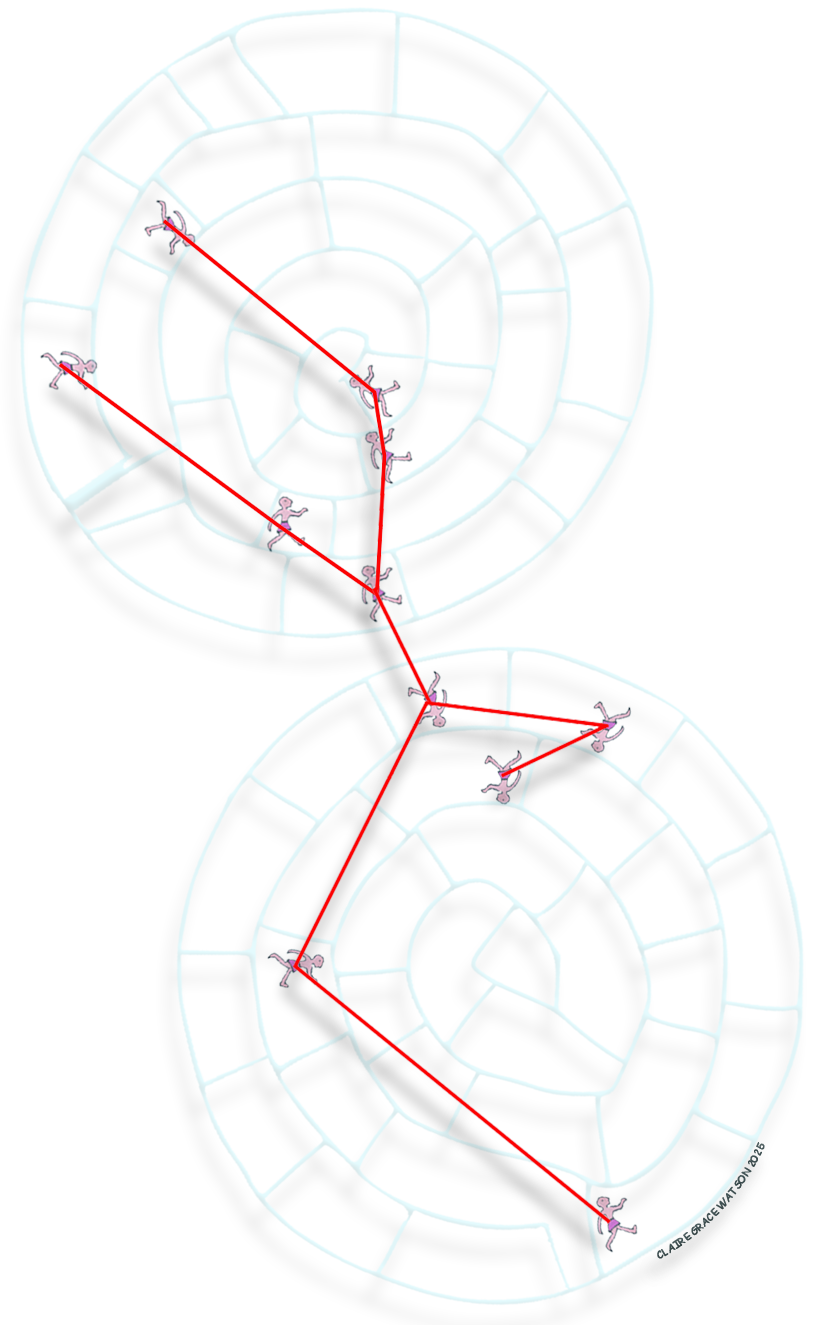 Constellation Taurus
Constellation Taurus
Side 1 (top), Side 2 (bottom) Phaistos Disk










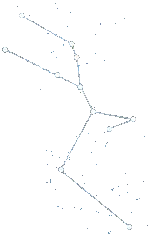
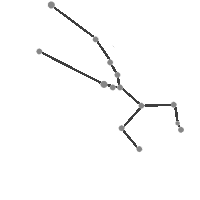 The Sexagesimal System in Astronomy on the Phaistos Disk
The Sexagesimal System in Astronomy on the Phaistos Disk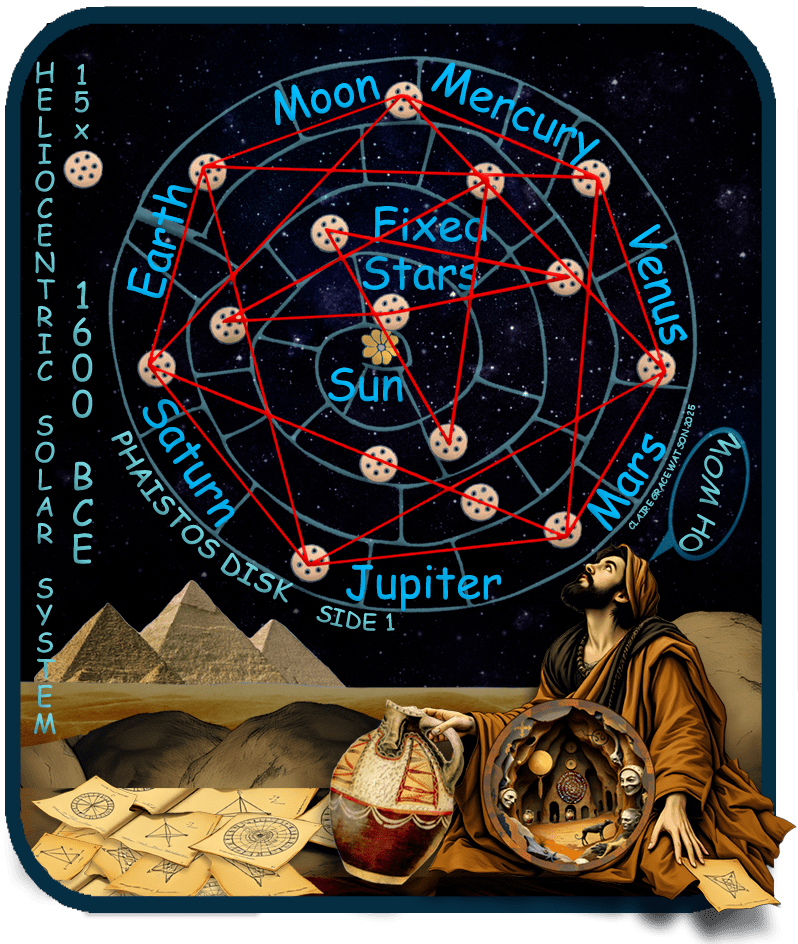
![]() And panta [all] is only a slight variant of pente [five]; and they (the Egyptians) call counting pempasasthai [reckoning by fives].
(Plutarch in Mead, Vol.1, p.234)
And panta [all] is only a slight variant of pente [five]; and they (the Egyptians) call counting pempasasthai [reckoning by fives].
(Plutarch in Mead, Vol.1, p.234)![]() Seen six times on side two of the disk and five times on side one is the five-branched tree. From "the ancient Chaldaean mystery-tradition of the Fire, 'five-branched' would thus mean man, or rather purified man, and the saying referred to the pruning of this tree." (Wallace Budge in Mead) The tree may also represent the five-branched heather-bush that grew around the coffin of Osiris, which was known as "chen-Osiris" or "Osiris-plant," the ivy consecrated to Osiris. (Wallace Budge in Mead) .
Seen six times on side two of the disk and five times on side one is the five-branched tree. From "the ancient Chaldaean mystery-tradition of the Fire, 'five-branched' would thus mean man, or rather purified man, and the saying referred to the pruning of this tree." (Wallace Budge in Mead) The tree may also represent the five-branched heather-bush that grew around the coffin of Osiris, which was known as "chen-Osiris" or "Osiris-plant," the ivy consecrated to Osiris. (Wallace Budge in Mead) . 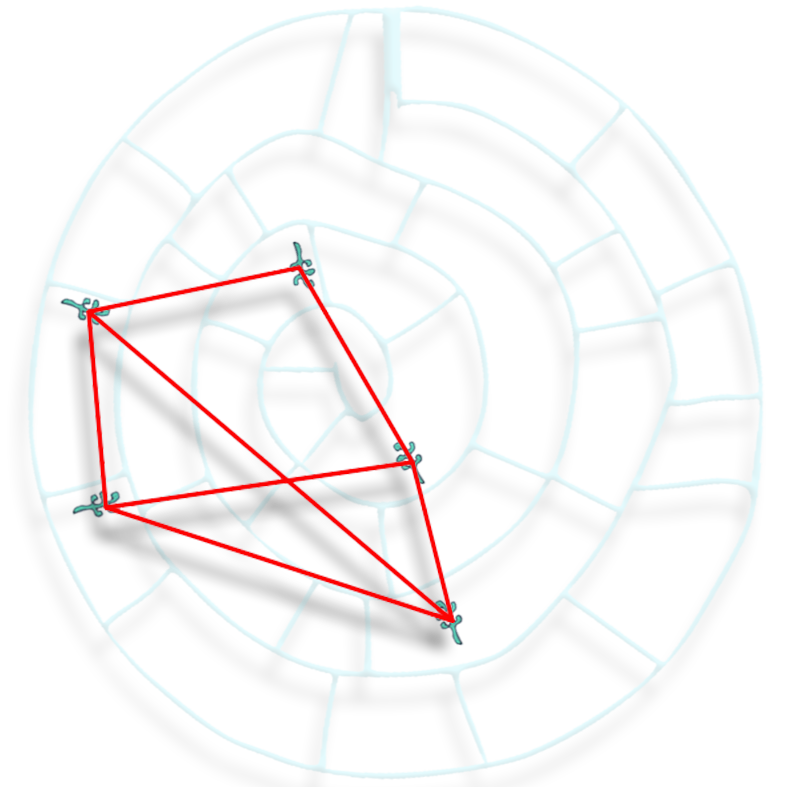 Phi Spiral
Phi Spiral Did the ancient people in Bronze Age Crete advance knowledge of the phi spiral? Knowing so much about geometry, why would they not? One of the pictographs on the disk is an equilateral triangle. Given the ancient love for syncretisms, it might also be people touring inside the Great Pyramid.
Did the ancient people in Bronze Age Crete advance knowledge of the phi spiral? Knowing so much about geometry, why would they not? One of the pictographs on the disk is an equilateral triangle. Given the ancient love for syncretisms, it might also be people touring inside the Great Pyramid.
 The shields on the disk each have seven dots in the shape of a hexagram. This could reference another Platonic solid, the hexahedron. Other symbols on the disk seem related to geometry. Remembering that the disk comes from a place with "phi" as part of its name--Phai-stos--(which the Greeks pronounce "fes-tos") the implication is that the people there studied the principles of phi and identified Platonic solids 1200 years before the birth of Plato. I believe they actively pursued knowledge of the sciences of geometry and astronomy and, at the same time, expressed their ideas and discoveries within the context of art, fabulous art being the known hallmark of their civilization while, at the same time, they are for some reason denied their massive contribution to astronomy.
The shields on the disk each have seven dots in the shape of a hexagram. This could reference another Platonic solid, the hexahedron. Other symbols on the disk seem related to geometry. Remembering that the disk comes from a place with "phi" as part of its name--Phai-stos--(which the Greeks pronounce "fes-tos") the implication is that the people there studied the principles of phi and identified Platonic solids 1200 years before the birth of Plato. I believe they actively pursued knowledge of the sciences of geometry and astronomy and, at the same time, expressed their ideas and discoveries within the context of art, fabulous art being the known hallmark of their civilization while, at the same time, they are for some reason denied their massive contribution to astronomy.
![]()
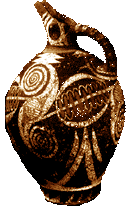
 Astronomical Ages, Bull Worship, and the Minotaur
Astronomical Ages, Bull Worship, and the Minotaur Overlighting this early human fascination with number and geometry were the stars, and perhaps their participation was not passive at all. There is the possibility of human brain embeddedness of starlight (left), which could account for the enlightenment, development, and expansion of human consciousness. We do not have to concede this intimate relationship with the stars to continue this theory of Minoan astronomy, but we do concede the contribution the stars make in the form of the astronomical ages.
Overlighting this early human fascination with number and geometry were the stars, and perhaps their participation was not passive at all. There is the possibility of human brain embeddedness of starlight (left), which could account for the enlightenment, development, and expansion of human consciousness. We do not have to concede this intimate relationship with the stars to continue this theory of Minoan astronomy, but we do concede the contribution the stars make in the form of the astronomical ages. ![]()
 In the Age of Taurus the bull was worshipped as divine. After
perhaps as many as 25,000 preceding years of bull worship, it is not surprising that the bull figured significantly in the Minoan civilization. A bull's
foot appears twice on the Phaistos Disk (left). Egypt had its Serapis, the sacred Osiris-Apis bull. Baal was widely worshipped,
later on the Israelites had their golden calf Moshe (Moses), and painted on the walls of buildings in ancient Sumer are humans with horns. The horns tell
of their status as gods and goddesses. (Minoan Queen Pasiphae drawn by Picasso, right)
In the Age of Taurus the bull was worshipped as divine. After
perhaps as many as 25,000 preceding years of bull worship, it is not surprising that the bull figured significantly in the Minoan civilization. A bull's
foot appears twice on the Phaistos Disk (left). Egypt had its Serapis, the sacred Osiris-Apis bull. Baal was widely worshipped,
later on the Israelites had their golden calf Moshe (Moses), and painted on the walls of buildings in ancient Sumer are humans with horns. The horns tell
of their status as gods and goddesses. (Minoan Queen Pasiphae drawn by Picasso, right)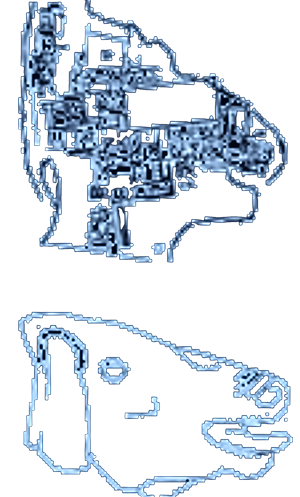 The idea of the bull-god
is foreign to many of us, although it should not be. Even today in India the bull is sacred, and in Spain and Mexico bull sports are still popular, as are
rodeos in the U.S. In Crete, the bull apparently was at the center of both religion and sport. This history of bull-worship clears up some of the mystery
of the Minoan legend of the Minotaur, a bull-being at the center of the bull sports and the maze. It clears up some mystery about Zeus, the Greek
god who often appeared as a bull. And it also shines some light on the worship of the bull-born Dionysis. (Left, Bronze Age palace
groundplan at Mallia, Crete compared with bull's head)
The idea of the bull-god
is foreign to many of us, although it should not be. Even today in India the bull is sacred, and in Spain and Mexico bull sports are still popular, as are
rodeos in the U.S. In Crete, the bull apparently was at the center of both religion and sport. This history of bull-worship clears up some of the mystery
of the Minoan legend of the Minotaur, a bull-being at the center of the bull sports and the maze. It clears up some mystery about Zeus, the Greek
god who often appeared as a bull. And it also shines some light on the worship of the bull-born Dionysis. (Left, Bronze Age palace
groundplan at Mallia, Crete compared with bull's head)
![]()
![]() In the Age of Aries the bull-god
gives over to the ram, whose Golden Fleece is the object of the quest of Jason and the Argonauts. They stopped worshipping the bull - in fact, they slayed
the bull in Crete, or Theseus did, in the legend of Theseus and the Minotaur. Following the Age of Aries is the Piscean Age in which a divine fish
symbolizes the Son of God as the "fisher of men." As we move into the Age of Aquarius, the cup is the symbol of the divine and holds the Water of Life, and
the Knights of the Round Table quest for the Holy Grail. One way or another, either directly or indirectly, we are influenced by the stars. Are they
really eternal powers? The Minoans apparently believed so.
In the Age of Aries the bull-god
gives over to the ram, whose Golden Fleece is the object of the quest of Jason and the Argonauts. They stopped worshipping the bull - in fact, they slayed
the bull in Crete, or Theseus did, in the legend of Theseus and the Minotaur. Following the Age of Aries is the Piscean Age in which a divine fish
symbolizes the Son of God as the "fisher of men." As we move into the Age of Aquarius, the cup is the symbol of the divine and holds the Water of Life, and
the Knights of the Round Table quest for the Holy Grail. One way or another, either directly or indirectly, we are influenced by the stars. Are they
really eternal powers? The Minoans apparently believed so.

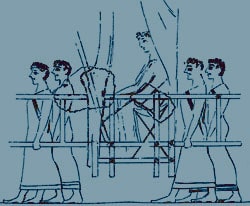 With this new power of thought and technological capability comes the wealth, ease and abundance that we associate with the Minoan civilization, a phenomenal flower
that blossomed in the middle of the Aegean Sea. The Greek creation myth tells the story of how it came to pass that the people were so blessed.
It was because the goddess gave them a son--Zeus--who in turn overthrew the old gods. It is not yet the Age of Pisces when the gift is the son of god.
It is the Age of Aries when the gift is the son of goddess. (left, palenquin pictograph on the Phaistos Disk, right, Minoan palenquin)The Birthing Stone of Rhea
With this new power of thought and technological capability comes the wealth, ease and abundance that we associate with the Minoan civilization, a phenomenal flower
that blossomed in the middle of the Aegean Sea. The Greek creation myth tells the story of how it came to pass that the people were so blessed.
It was because the goddess gave them a son--Zeus--who in turn overthrew the old gods. It is not yet the Age of Pisces when the gift is the son of god.
It is the Age of Aries when the gift is the son of goddess. (left, palenquin pictograph on the Phaistos Disk, right, Minoan palenquin)The Birthing Stone of Rhea
Birthing the Immortals in Bronze Age Crete In ancient Egyptian-Cretan terminologies, the Ka-Ba, then, is the collective Being (Ka-Ba-La) who continues on after death in a soul vehicle called the Mer-Ka-Ba, Mer meaning "place of ascending."
In ancient Egyptian-Cretan terminologies, the Ka-Ba, then, is the collective Being (Ka-Ba-La) who continues on after death in a soul vehicle called the Mer-Ka-Ba, Mer meaning "place of ascending." 

![]()
![]() Auspiciously born in the first day (first line segment at center of disk, side 1) of the first month of the New Year, at the heliacal rising of Sirius, the child is born under the protection of Rhea. A baby daughter might take up her place as the queen of a palace and give birth to more divine Curetes. She will be the flower (1) at the center of the birthing stone, like her mother. And if a son, he may shave his head and become a priest (2) in the service of the goddess. Or, being a true Minyae or Minoan, he may take up the oar to become an Argonaut or claim his place as another King Minos. (3)
Auspiciously born in the first day (first line segment at center of disk, side 1) of the first month of the New Year, at the heliacal rising of Sirius, the child is born under the protection of Rhea. A baby daughter might take up her place as the queen of a palace and give birth to more divine Curetes. She will be the flower (1) at the center of the birthing stone, like her mother. And if a son, he may shave his head and become a priest (2) in the service of the goddess. Or, being a true Minyae or Minoan, he may take up the oar to become an Argonaut or claim his place as another King Minos. (3) 
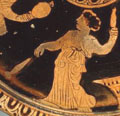

![]() Born on the second day of the first month, under the protection of Poseidon, the divine son may be an Olympian in the tradition of Herakles. (1) Or, if a daughter, she may be a designer of clothes, overseeing the creation of the beautiful gowns worn by the elegant women of Minoan Crete and teaching the use of the spindle. (2) Just as the Phoenician [Cretan] men are skilled beyond others as mariners, so are the women the most
accomplished at the loom. The goddess Athene has given them much wisdom as
workers, and richest fancy.
Born on the second day of the first month, under the protection of Poseidon, the divine son may be an Olympian in the tradition of Herakles. (1) Or, if a daughter, she may be a designer of clothes, overseeing the creation of the beautiful gowns worn by the elegant women of Minoan Crete and teaching the use of the spindle. (2) Just as the Phoenician [Cretan] men are skilled beyond others as mariners, so are the women the most
accomplished at the loom. The goddess Athene has given them much wisdom as
workers, and richest fancy.
![]() 1
1![]() 2
2![]() 3
3![]() 4
4![]() 5
5 6
6 7
7

![]()
![]() Born on the 4th day, under the protection of Hestia, the divine powers expressed in the 1st day now reappear in the 4th, and the birth is very auspicious. The daughter may become a queen, the son a priest or Minyae king. (A repetition of the three pictographs in the first line segment are repeated in the fourth.)
Born on the 4th day, under the protection of Hestia, the divine powers expressed in the 1st day now reappear in the 4th, and the birth is very auspicious. The daughter may become a queen, the son a priest or Minyae king. (A repetition of the three pictographs in the first line segment are repeated in the fourth.)
![]()
![]()


![]()

![]() Born on the 6th day, under the protection of Ares, the birth is auspicious. The son may become an Olympic runner like Herakles (1), and the daughter again may design clothing and use the spindle (2). Perhaps, the son will carry a shield (3) and become warrior (4) in honor of the god under which he was born -- Ares, the god of war.
Born on the 6th day, under the protection of Ares, the birth is auspicious. The son may become an Olympic runner like Herakles (1), and the daughter again may design clothing and use the spindle (2). Perhaps, the son will carry a shield (3) and become warrior (4) in honor of the god under which he was born -- Ares, the god of war.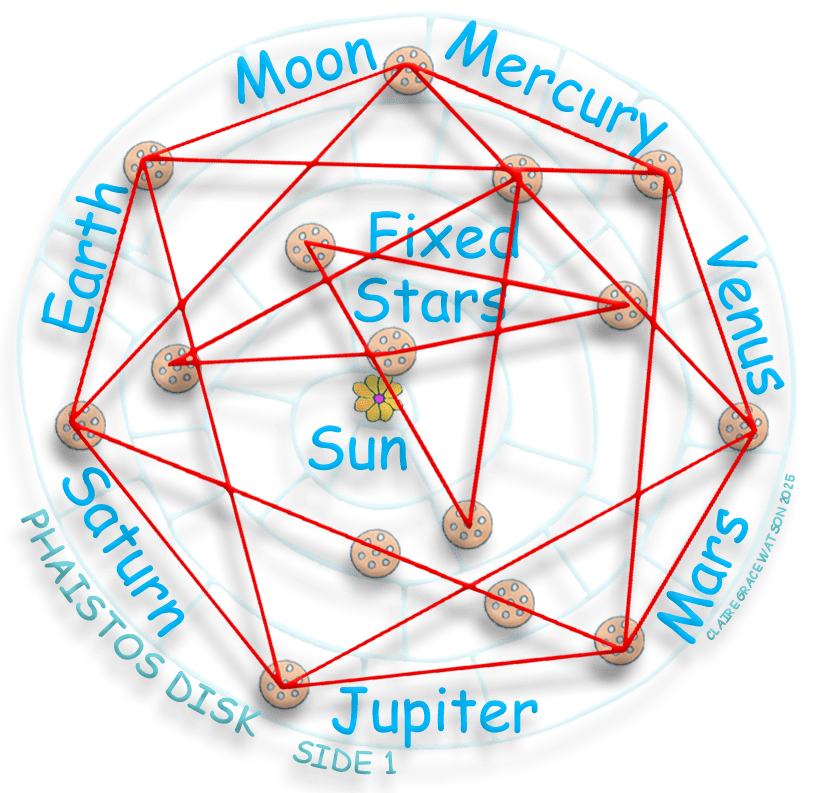
 The Watcher Unseen
The Watcher Unseen The symbols (right) that preceed the fetus in the thigh are catalogued by
Sir Arthur Evans many times because they recur so often and with so many various or alternate depictions. They look like a comb (Evans originally
called it a fence) and a smoking cucumber. Then the thigh is surrounded by three images, all similar, that appear to be nails but that probably are stars.
Most likely, this grouping indicates a constellation, possibly Taurus, and the comb and smoking cucumber spell out the name of the constellation
which also could be the Minoan names, whatever they were, for Zeus and Dionysis.
The symbols (right) that preceed the fetus in the thigh are catalogued by
Sir Arthur Evans many times because they recur so often and with so many various or alternate depictions. They look like a comb (Evans originally
called it a fence) and a smoking cucumber. Then the thigh is surrounded by three images, all similar, that appear to be nails but that probably are stars.
Most likely, this grouping indicates a constellation, possibly Taurus, and the comb and smoking cucumber spell out the name of the constellation
which also could be the Minoan names, whatever they were, for Zeus and Dionysis.
 The "comb" in Linear B has been deciphered as Ja. To make the sound,
bring the "fence of the teeth" together to pronouce "Ja." Next, bring the lips together and blow a little, like the smoking cucumber, to say "Wa."
Jawa. What we just said is the Biblical name of God - Jahwah - or Jehovah. Now we see what perhaps was originally meant by Jahwah - Father-Son or Zeus
(Jah)-Dionysis (Wah) and the beginnings of the patriarchy - the beginning of His-story - both in civilization and in religion. In Crete, therefore,
the patriarchy and His-story is born from the matriarchy and Her-story.
The "comb" in Linear B has been deciphered as Ja. To make the sound,
bring the "fence of the teeth" together to pronouce "Ja." Next, bring the lips together and blow a little, like the smoking cucumber, to say "Wa."
Jawa. What we just said is the Biblical name of God - Jahwah - or Jehovah. Now we see what perhaps was originally meant by Jahwah - Father-Son or Zeus
(Jah)-Dionysis (Wah) and the beginnings of the patriarchy - the beginning of His-story - both in civilization and in religion. In Crete, therefore,
the patriarchy and His-story is born from the matriarchy and Her-story.
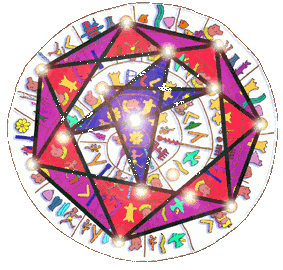
Pagemap
Bookmap![]() Comments
Comments
 "I am very impressed with your achievement and I strongly believe that you deserve complete recognition both in Greece and abroad for your profound revelation. (Nick Kallianiotis)
"I am very impressed with your achievement and I strongly believe that you deserve complete recognition both in Greece and abroad for your profound revelation. (Nick Kallianiotis)